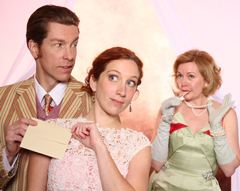
At the dawn of the French Revolution, when the ruling class made extravagant displays of their wealth and power, Pierre-Augustin Caron de Beaumarchais wrote The Marriage of Figaro, one of France's most controversial plays about lower classes striving for freedom and women breaking from traditional roles. In order to resonate with contemporary audiences, director Jonathan Berry sets Ranjit Bolt's adaptation of The Marriage of Figaro in 1950s France, a gilded mirror to Beaumarchais' own time. Remy Bumppo will present Beaumarchais' 18th century play adapted by Ranjit Bolt from Nov. 13, 2008 through Jan. 4, 2009 in the Upstairs Mainstage of the Greenhouse Theater Center, 2257 N. Lincoln Ave.
In post World War II France, female gender politics began to lose its "Rosie the Riveter" momentum. Christian Dior's "new look" emphasized returning the female silhouette to a "traditional" shape, and thus returning women to a traditional role. The production's 1950s concept is "about finding the parallel between the coming rebuke of the 1780s class system and the struggle that was felt in France in the early 1950s between the death of French colonialism and the divide between the right-wing conservatives and the growing communist party," says Berry. "After the war, everyone was pushed back into their more traditional gender and class roles; this production is invested in the tension created by that push."
With a quick jaunt to France, where farce reigns supreme, Remy Bumppo wants to stretch the boundaries beyond English and American plays with brilliant language. Through Figaro, they add fun physicality to the beautiful language. "French farce can easily be dismissed," says Berry, "but what grounds The Marriage of Figaro is the political argument."
The Marriage of Figaro runs Nov. 13 2008 through Jan. 4 2009 in the Upstairs Mainstage of the Greenhouse Theater Center. For tickets and more information visit www.remybumppo.org.

 Follow Us On Twitter
Follow Us On Twitter